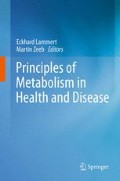Abstract
The blood vessels conduct blood from the heart to the tissues and back, thus achieving continuous supply of oxygen and nutrients, removal of waste products, and – when needed – delivery of leukocytes to the organs. In one overall circulation cycle, the heart is passed two times in order to pump the blood through the other tissues and lungs (see chapter “Overview” under part “Heart”). Starting in the left ventricle of the heart, oxygenated blood flows into the systemic circulation through the aorta, and then into the large conduit arteries, which subsequently divide into smaller conduit arteries, resistance arteries, and the microcirculation. There, arterioles branch out into capillaries, the smallest blood vessels and site of solute and gas exchange. Capillaries merge into venules, and those merge into veins, conducting the blood toward the right heart. From the right heart, blood flows into the pulmonary artery to enter the pulmonary circulation, where it is reoxygenated. The blood then returns to the left heart.
Access this chapter
Tax calculation will be finalised at checkout
Purchases are for personal use only
References
Aird WC (2007) Phenotypic heterogeneity of the endothelium: I. Structure, function, and mechanisms. Circ Res 100:158–173
Mehta D, Malik AB (2006) Signaling mechanisms regulating endothelial permeability. Physiol Rev 86:279–367
Armulik A, Genové G, Mäe M, Nisancioglu MH, Wallgard E, Niaudet C, He L, Norlin J, Lindblom P, Strittmatter K, Johansson BR, Betsholtz C (2010) Pericytes regulate the blood-brain barrier. Nature 468:557–561
Somlyo AP, Somlyo AV (2003) Ca2+ sensitivity of smooth muscle and nonmuscle myosin II: modulated by G proteins, kinases, and myosin phosphatase. Physiol Rev 83:1325–1358
Bian K, Doursout MF, Murad F (2008) Vascular system: role of nitric oxide in cardiovascular diseases. J Clin Hypertens (Greenwich) 10:304–310
De Caterina R, Libby P, Peng HB, Thannickal VJ, Rajavashisth TB, Gimbrone MA Jr, Shin WS, Liao JK (1995) Nitric oxide decreases cytokine-induced endothelial activation. Nitric oxide selectively reduces endothelial expression of adhesion molecules and proinflammatory cytokines. J Clin Invest 96:60–68
Fishman AP (1982) Endothelium: a distributed organ of diverse capabilities. Ann N Y Acad Sci 401:1–8
VWM van Hinsbergh (2012) Endothelium – role in regulation of coagulation and inflammation. Semin Immunopathol 34:93–106
Pober JS, Sessa WC (2007) Evolving functions of endothelial cells in inflammation. Nat Rev Immunol 7:803–815
Davies PF (2009) Hemodynamic shear stress and the endothelium in cardiovascular pathophysiology. Nat Clin Pract Cardiovasc Med 6:16–26
Mendelsohn ME, Karas RH (2010) Rapid progress for non-nuclear estrogen receptor signaling. J Clin Invest 120:2277–2279
Aghamohammadzadeh R, Withers S, Lynch F, Greenstein A, Malik R, Heagerty A (2012) Perivascular adipose tissue from human systemic and coronary vessels: the emergence of a new pharmacotherapeutic target. Br J Pharmacol 165:670–682
Author information
Authors and Affiliations
Corresponding author
Editor information
Editors and Affiliations
Rights and permissions
Copyright information
© 2014 Springer-Verlag Wien
About this chapter
Cite this chapter
van Hinsbergh, V.W.M., Meijer, R., Eringa, E.C. (2014). Overview. In: Lammert, E., Zeeb, M. (eds) Metabolism of Human Diseases. Springer, Vienna. https://doi.org/10.1007/978-3-7091-0715-7_38
Download citation
DOI: https://doi.org/10.1007/978-3-7091-0715-7_38
Published:
Publisher Name: Springer, Vienna
Print ISBN: 978-3-7091-0714-0
Online ISBN: 978-3-7091-0715-7
eBook Packages: Biomedical and Life SciencesBiomedical and Life Sciences (R0)

